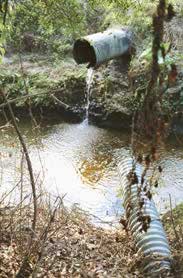Water pollutants purged

Glowing catalyst can spot one part pollutant per million of water <br>© PhotoDisc <br>
Smart process cleans up contaminated water.
A smart material identifies and destroys toxic pollutants in water. When exposed to the offending molecules, tiny light-emitting zinc oxide particles glow dimly, burn them up, and glow brightly to show they’ve finished1.
The advantage of such an approach, say Prashant Kamat and co-workers at the University of Notre Dame in Indiana, is that the energy-consuming burn-up stage switches on only when pollutants are present.
Kamat’s team is training its cross-hairs on organic aromatic pollutants such as chlorinated phenols. These are used as wood preservatives and pesticides, and are often the by-products of paper pulp milling.
Polychlorinated biphenyls (PCBs) are related substances that are widespread contaminants in industrialized nations. They are used to manufacture paints, plastics, adhesives and electrical goods, and as hydraulic and cooling fluids. Municipal incinerators produce similar chlorinated aromatic compounds called dioxins.
All these chemicals are toxic in high doses, and are possibly carcinogenic.
One widely studied new method for decontaminating water is photocatalytic oxidation: the burning-up of organic molecules in air, stimulated by a light-sensitive catalyst. The most common catalyst in these studies (which have not yet delivered a commercial process) is titanium dioxide.
Zinc oxide might prove more versatile, the Notre Dame group thinks. It destroys organic molecules in much the same way as titanium dioxide, but can also sense the presence of these compounds in the first place.
Zinc oxide is fluorescent: it absorbs ultraviolet light and re-emits the energy as green light. This light level falls by 15% when zinc oxide is exposed to just one part per million of chlorinated aromatic molecules – a few drops in a bath of water.
When such a solution is exposed to strong UV irradiation, a film of zinc oxide particles reacts with the organic molecules, converting them to harmless substances. After several hours of irradiation, the film’s fluorescence increases, because there is less chlorinated compound left.
In a water-purification system, this brightening green light could signal that most of the contaminant has been destroyed, triggering a shutdown of the ultraviolet irradiation.
Whether such a system will be commercially viable depends on whether the contaminants can be removed efficiently and quickly enough.
References
- Kamat, P. V., Huehn, R. & Nicolaescu, R. A ’sense and shoot’ approach for photocatalytic degradation of organic contaminants in water. Journal of Physical Chemistry B, 106, 788 – 794, (2002).
Media Contact
All latest news from the category: Ecology, The Environment and Conservation
This complex theme deals primarily with interactions between organisms and the environmental factors that impact them, but to a greater extent between individual inanimate environmental factors.
innovations-report offers informative reports and articles on topics such as climate protection, landscape conservation, ecological systems, wildlife and nature parks and ecosystem efficiency and balance.
Newest articles

High-energy-density aqueous battery based on halogen multi-electron transfer
Traditional non-aqueous lithium-ion batteries have a high energy density, but their safety is compromised due to the flammable organic electrolytes they utilize. Aqueous batteries use water as the solvent for…

First-ever combined heart pump and pig kidney transplant
…gives new hope to patient with terminal illness. Surgeons at NYU Langone Health performed the first-ever combined mechanical heart pump and gene-edited pig kidney transplant surgery in a 54-year-old woman…

Biophysics: Testing how well biomarkers work
LMU researchers have developed a method to determine how reliably target proteins can be labeled using super-resolution fluorescence microscopy. Modern microscopy techniques make it possible to examine the inner workings…





















